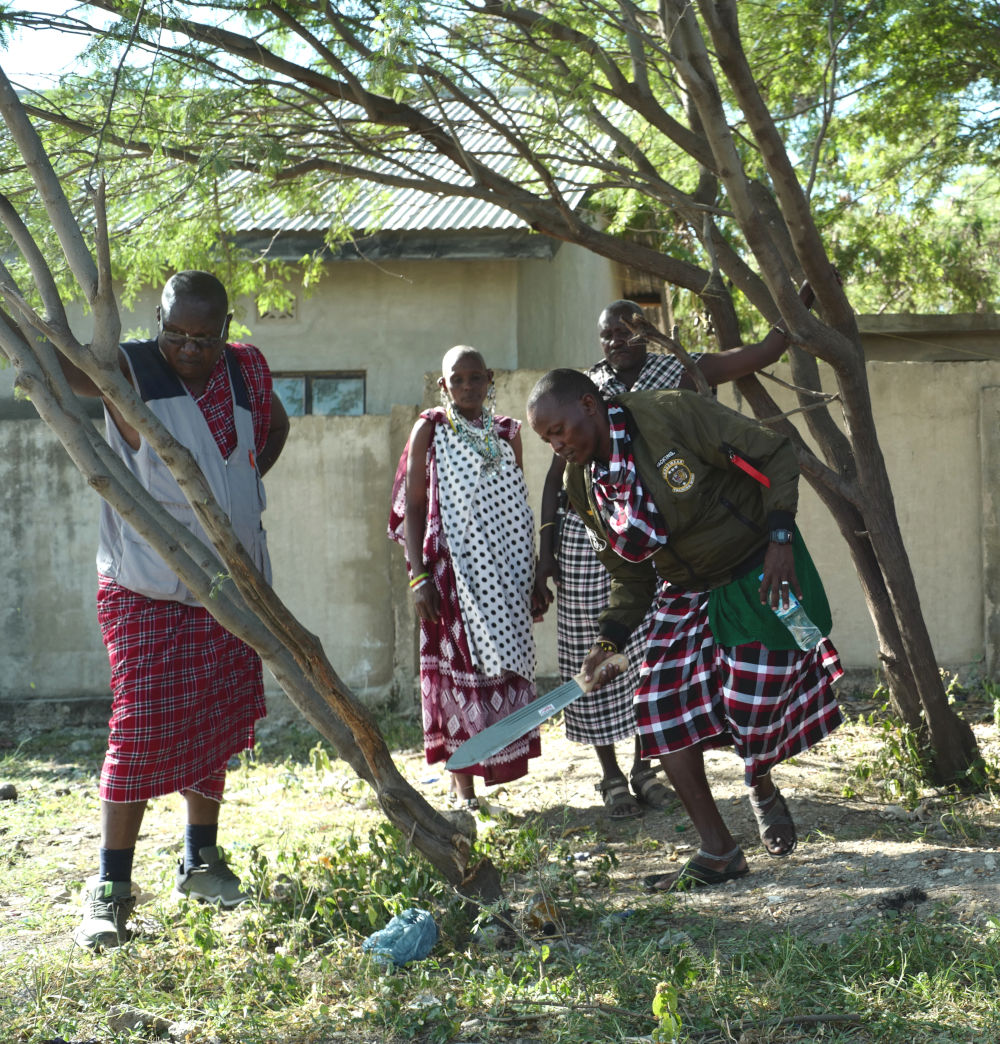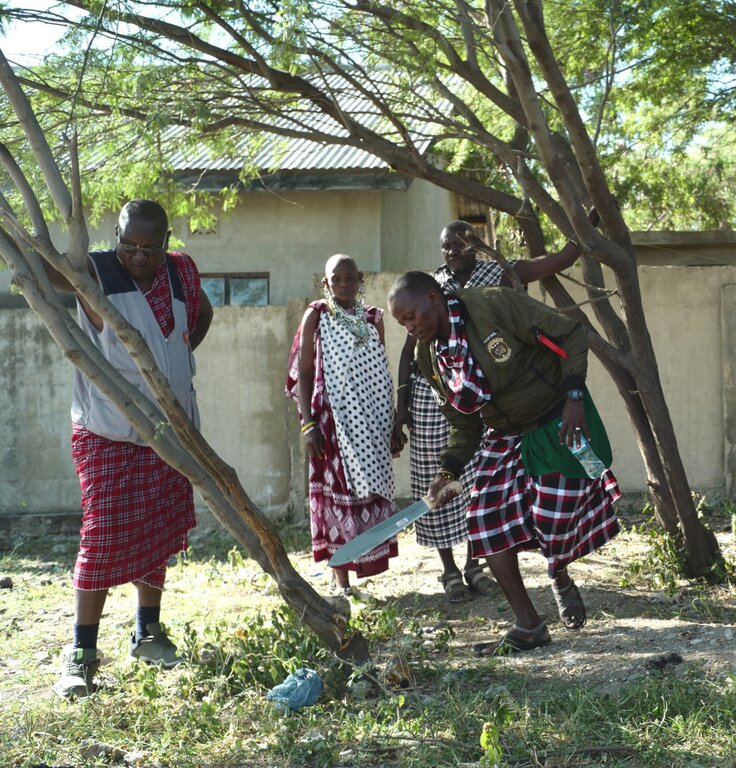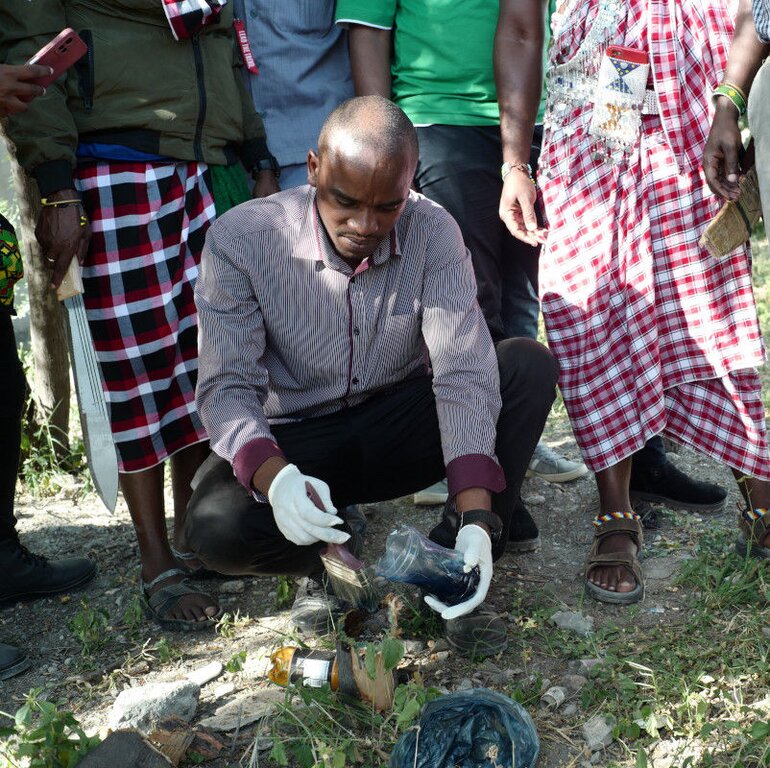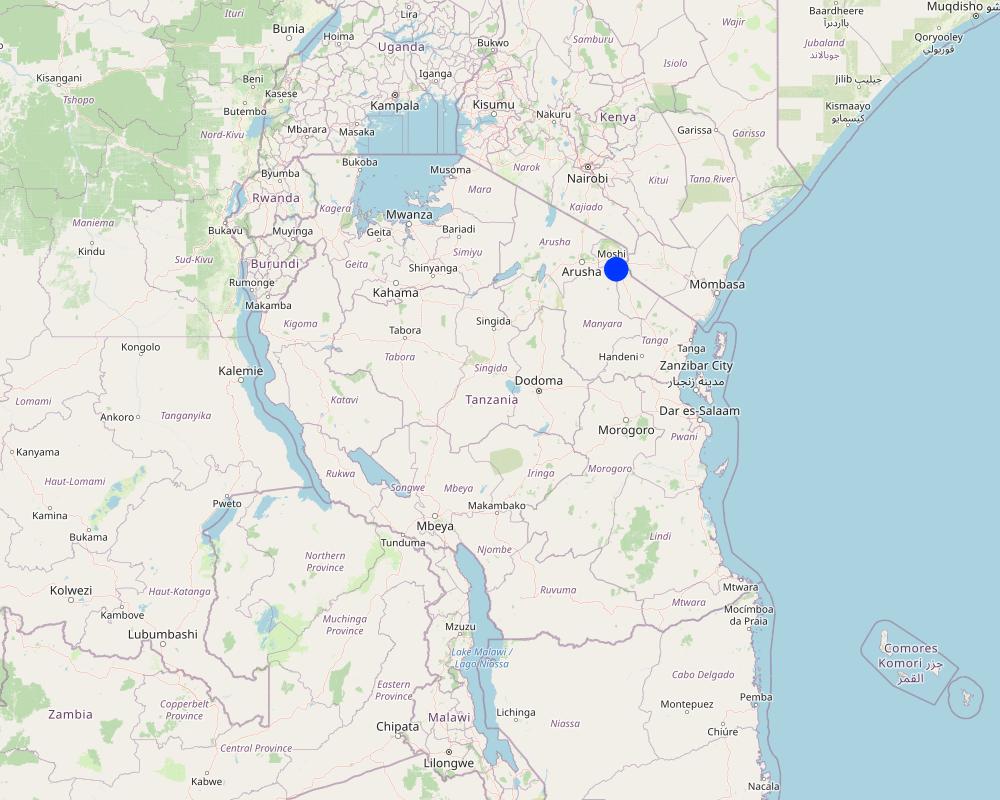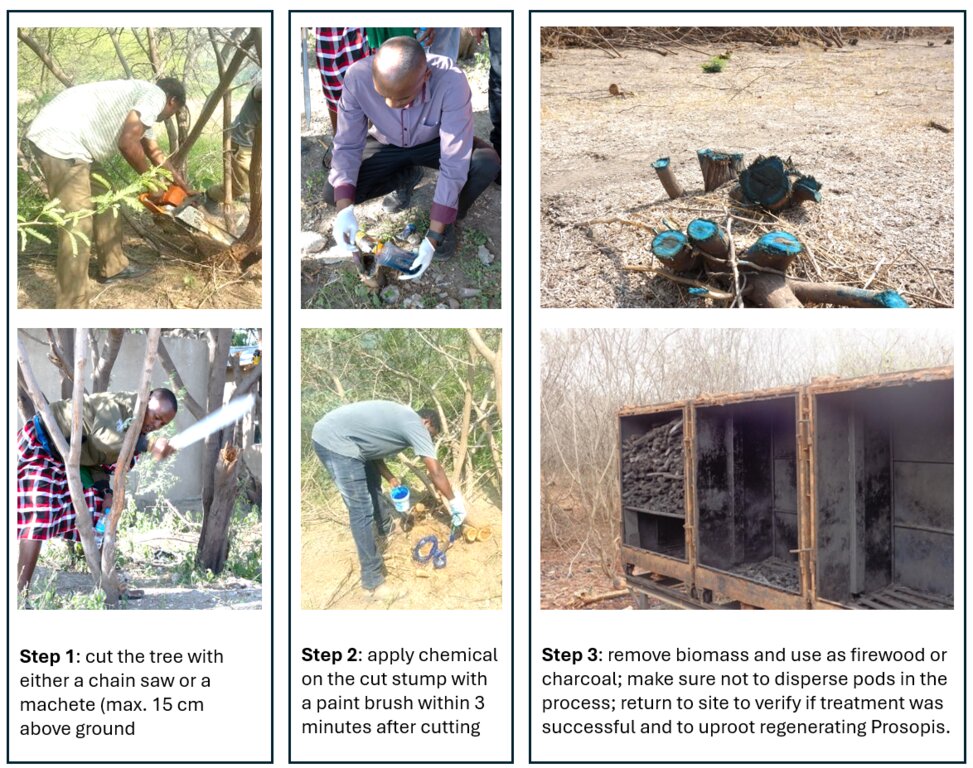Cut stump [坦桑尼亚联合共和国]
- 创建:
- 更新:
- 编制者: John Mbwambo
- 编辑者: Albrecht Ehrensperger, Beatrice Otieno
- 审查者: Christian Hergarten, Albrecht Ehrensperger
Kukata visiki
technologies_6207 - 坦桑尼亚联合共和国
查看章节
全部展开 全部收起1. 一般信息
1.2 参与该技术评估和文件编制的资源人员和机构的联系方式
有助于对技术进行记录/评估的项目名称(如相关)
R4D Woody Weeds有助于对技术进行记录/评估的机构名称(如相关)
Tanzania Forestry Research Institute (TAFORI) - 坦桑尼亚联合共和国有助于对技术进行记录/评估的机构名称(如相关)
CDE Centre for Development and Environment (CDE Centre for Development and Environment) - 瑞士有助于对技术进行记录/评估的机构名称(如相关)
CABI Switzerland (CABI Switzerland) - 瑞士1.3 关于使用通过WOCAT记录的数据的条件
编制者和关键资源人员接受有关使用通过WOCAT记录数据的条件。:
是
1.4 所述技术的可持续性声明
这里所描述的技术在土地退化方面是否存在问题,导致无法被认为是一种可持续的土地管理技术?:
否
注释:
It is an SLM technology and is being tested for out-scaling in areas invaded by Prosopis juliflora
2. SLM技术的说明
2.1 技术简介
技术定义:
The cut stump technology is probably the most effective means of killing mature Prosopis trees using the herbicide Triclon with active ingredients Triclopyr 480g/l . Stems are cut with a chainsaw as close to the ground as possible and the herbicide is applied to the stump within three minutes of cutting using a paintbrush. The young plants with less than 2 cm root collar diameter should be uprooted by hand. The treatment is repeated after three months on resprouting stumps.
2.2 技术的详细说明
说明:
The technology is highly relevant and effective for controlling the invasion of Prosopis spp. in both agricultural and grassland areas where the species is considered problematic. It is particularly suitable for dry regions prone to Prosopis invasions, especially those experiencing drought periods of more than four months, which allow the herbicide to take significant effect. To avoid chemical contamination, the technology should only be applied in areas located more than 200 meters away from water sources.
This method requires simple tools to cut trees efficiently, with a chainsaw being recommended for the task. However, in areas where infestations cover less than 20 percent of the land, simpler tools such as machetes can be used. Trees should be cut as close to the ground as possible (no more than 15 cm stump height), and herbicide should be applied to the stump within three minutes of cutting. The treatment should be carried out during the dry season, ensuring no rainfall is expected within a month to allow for complete absorption of the herbicide.
A minimum of two people equipped with proper protective clothing is required for this operation: one to cut the trees and another to apply the herbicide and clear the cut branches. The herbicide, typically Triclopyr, is often mixed with diesel at a 1:50 ratio. A follow-up application is crucial to target any trees that were not completely killed during the initial treatment.
Herbicides can be ordered from Arysta Co. Ltd in Tanzania at a cost of TZS 1,000,000 (USD 430) per 20 liters. The advantages of using this technology include its effectiveness in killing the trees and the ability to utilize the cut branches as fuelwood or for making Prosopis charcoal. However, the major drawbacks include limited information leading to scepticism among land users regarding the health risks and potential long-term effects on soil quality, as well as the limited availability of the herbicide in local agro-stores.
2.3 技术照片
2.5 已应用该技术的、本评估所涵盖的国家/地区/地点
国家:
坦桑尼亚联合共和国
区域/州/省:
Kilimanjaro
有关地点的进一步说明:
Kahe
具体说明该技术的分布:
- 适用于特定场所/集中在较小区域
技术现场是否位于永久保护区?:
否
Map
×2.6 实施日期
注明实施年份:
2017
如果不知道确切的年份,请说明大概的日期:
- 不到10年前(最近)
2.7 技术介绍
详细说明该技术是如何引入的:
- 在实验/研究期间
注释(项目类型等):
The technology was introduced through experimentation during the implementation of the Woody Weeds Project. For more details visit www.woodyweeds.org
3. SLM技术的分类
3.1 该技术的主要目的
- 改良生产
- 减少、预防、恢复土地退化
- 保护生态系统
- 保持/提高生物多样性
- 创造有益的社会影响
3.2 应用该技术的当前土地利用类型
同一土地单元内混合使用的土地::
是
具体说明混合土地使用(作物/放牧/树木):
- 农牧业(包括农牧结合)

农田
- 一年一作
年作 - 具体指明作物:
- 谷物类 - 玉米
- 蔬菜 - 其他
年作制度:
连作蔬菜
采用间作制度了吗?:
是
如果是,说明哪些作物是间作的:
Maize and tomato, Maize and black nightshade
采用轮作制度了吗?:
是
如果是,请具体说明:
Maize with tomato, black nightshade with bell peppers

牧场
粗放式放牧:
- 季节性迁移的放牧主义
是否实行作物与牲畜的综合管理?:
是
如果是,请具体说明:
Livestock are released to graze around fenced farmlands or graze/feed on stalks left after harvests.
产品和服务:
- 肉类
品种:
牛 - 非奶牛牛肉
计数:
10
注释:
Crop cultivation and grazing are rotated to avoid crop damage and sometimes cropland is fenced with thorny branches of Prosopis juliflora to deter livestock from accessing the crop fields.
3.3 由于技术的实施,土地使用是否发生了变化?
由于技术的实施,土地使用是否发生了变化?:
- 否(继续问题3.4)
同一土地单元内混合使用的土地::
是
具体说明混合土地使用(作物/放牧/树木):
- 农牧业(包括农牧结合)

农田
- 一年一作
年作制度:
连作蔬菜
采用间作制度了吗?:
是
如果是,说明哪些作物是间作的:
Maize and tomato, Maize and black nightshade
采用轮作制度了吗?:
是
如果是,请具体说明:
Maize with tomato, black nightshade with bell peppers

牧场
粗放式放牧:
- 季节性迁移的放牧主义
注释:
Crop cultivation and grazing are rotated to avoid crop damage and sometimes cropland is fenced with thorny branches of Prosopis juliflora to deter livestock from accessing the crop fields.
3.4 供水
该技术所应用土地的供水:
- 混合雨水灌溉
注释:
Cultivation of vegetables relies fully on irrigation. Water is obtained from shallow bore holes and pumped out to irrigate the fields.
3.5 该技术所属的SLM组
- Weed control and management
3.6 包含该技术的可持续土地管理措施

管理措施
- M5:物种组成的控制/变化
注释:
The cut stump technology is considered a control of species composition because the intention is to remove or reduce the abundance of the invasive species and improve performance of desired native plant species.
3.7 该技术强调的主要土地退化类型

生物性退化
- Bs:质量和物种组成/多样性的下降
注释:
The technology controls and reduces the density of an invasive tree Prosopis juliflora on grazing land and cultivated fields.
3.8 防止、减少或恢复土地退化
具体数量名该技术与土地退化有关的目标:
- 修复/恢复严重退化的土地
注释:
The land degradation is due to change of vegetation cover as a result of increasing abundance of an invasive tree.
4. 技术规范、实施活动、投入和成本
4.1 该技术的技术图纸
技术规范(与技术图纸相关):
Stems of Prosopis should be cut very close to the ground (ca. 15 cm from the ground)
作者:
Albrecht Ehrensperger (based on photos from different authors)
日期:
03/07/2024
4.2 有关投入和成本计算的一般信息
具体说明成本和投入是如何计算的:
- 每个技术区域
注明尺寸和面积单位:
0.01 Hectares
其它/国家货币(具体说明):
Tanzanian Shilling
如相关,注明美元与当地货币的汇率(例如1美元=79.9巴西雷亚尔):1美元=:
2400.0
注明雇用劳工的每日平均工资成本:
20,000
4.3 技术建立活动
| 活动 | 时间(季度) | |
|---|---|---|
| 1. | Acquisition of Chemical (Triclon) | anytime of the year |
| 2. | Hiring a Chain Saw | anytime of the year |
| 3. | Cutting of stems | During dry season (normally January - March) |
| 4. | Chemical application using paint brush | Within five minutes after cutting the stems |
| 5. | Separating intertwined branches | Immediately after cutting the stems |
| 6. | Cleaning the area from thorns and small branches | Immediately after cutting the stems |
| 7. | 2nd treatments of stumps | Two months after chemical treatments and during dry season |
| 8. | 3rd treatment of stumps | After 6-8 months after 1st treatment and should be during dry season (normally September - October) |
| 9. | Removing regenerating Prosopis | Every three months after 1st treatment for 15 months |
注释:
It is important to find out which chemical is registered for use in your area. Triclopyr was easy to use and very effective to kill trees with stem diameter > 5cm.
4.4 技术建立所需要的费用和投入
| 对投入进行具体说明 | 单位 | 数量 | 单位成本 | 每项投入的总成本 | 土地使用者承担的成本% | |
|---|---|---|---|---|---|---|
| 劳动力 | Cutting of stems | Mandays | 2.0 | 20000.0 | 40000.0 | |
| 劳动力 | Chemical application using paint brush | Mandays | 1.0 | 20000.0 | 20000.0 | |
| 劳动力 | Separating intertwined branches | Mandays | 2.0 | 20000.0 | 40000.0 | |
| 劳动力 | Removing small branches and debris | Mandays | 1.0 | 20000.0 | 20000.0 | |
| 设备 | Hiring a Chain saw | Hours | 8.0 | 4000.0 | 32000.0 | |
| 肥料和杀菌剂 | Triclon (480g/l Triclopyr) | Litres | 1.2 | 50000.0 | 60000.0 | |
| 技术建立所需总成本 | 212000.0 | |||||
| 技术建立总成本,美元 | 88.33 | |||||
如果土地使用者负担的费用少于100%,请注明由谁负担其余费用:
R4D Woody Weeds Project
注释:
The estimated costs is for an area covered with > 80 Prosopis juliflora. The technology has not yet been out-scaled. The main challenge with its adoption is the availability of the chemical Triclon.
4.5 维护/经常性活动
| 活动 | 时间/频率 | |
|---|---|---|
| 1. | Uprooting regenerating Prosopis | after every three months |
| 2. | Chemical application | Every dry season up to 15 months |
注释:
To ensure effective control it is important to uproot all regenerating Prosopis after every three months.
4.6 维护/经常性活动所需要的费用和投入(每年)
| 对投入进行具体说明 | 单位 | 数量 | 单位成本 | 每项投入的总成本 | 土地使用者承担的成本% | |
|---|---|---|---|---|---|---|
| 劳动力 | uprooting regenerating Prosopis | Mandays | 5.0 | 20000.0 | 100000.0 | |
| 肥料和杀菌剂 | Triclon (triclopyr 480g/L) | Litres | 0.6 | 50000.0 | 30000.0 | |
| 技术维护所需总成本 | 130000.0 | |||||
| 技术维护总成本,美元 | 54.17 | |||||
如果土地使用者负担的费用少于100%,请注明由谁负担其余费用:
R4D Woody Weeds
注释:
After every three months, uprooting of all regenerating Prosopis should be done before they develop deep roots and start competing with desired plants.
4.7 影响成本的最重要因素
描述影响成本的最决定性因素:
(i) Availability of labor during farming seasons
(ii) Distance from and availability of agro-chemical stores
(iii) Size of Prosopis trees
(iv) Length of dry and wet seasons (long wet season makes many seed of Prosopis to germinate and long dry season makes it difficult to work out under the sun)
5. 自然和人文环境
5.1 气候
年降雨量
- < 250毫米
- 251-500毫米
- 501-750毫米
- 751-1,000毫米
- 1,001-1,500毫米
- 1,501-2,000毫米
- 2,001-3,000毫米
- 3,001-4,000毫米
- > 4,000毫米
指定年平均降雨量(若已知),单位为mm:
400.00
有关降雨的规范/注释:
Extended dry seasons from September to mid-March. Bi-annual rainfall, with most rain falling from April to Mid and short rains from Mid November to December.
注明所考虑的参考气象站名称:
TPC Sugar Manufacturing Company
农业气候带
- 半干旱
The area is very dry and agriculture is only possible through irrigation. Temperatures are very high during the day, at about 30 degrees Celcius. However, domestic animals such as cattle, goats, and sheep thrive fairly well in the area and there is very good hay during rainy seasons.
5.2 地形
平均坡度:
- 水平(0-2%)
- 缓降(3-5%)
- 平缓(6-10%)
- 滚坡(11-15%)
- 崎岖(16-30%)
- 陡峭(31-60%)
- 非常陡峭(>60%)
地形:
- 高原/平原
- 山脊
- 山坡
- 山地斜坡
- 麓坡
- 谷底
垂直分布带:
- 0-100 m a.s.l.
- 101-500 m a.s.l.
- 501-1,000 m a.s.l.
- 1,001-1,500 m a.s.l.
- 1,501-2,000 m a.s.l.
- 2,001-2,500 m a.s.l.
- 2,501-3,000 m a.s.l.
- 3,001-4,000 m a.s.l.
- > 4,000 m a.s.l.
说明该技术是否专门应用于:
- 不相关
关于地形的注释和进一步规范:
Extensive flat terrain interrupted by seasonal rivers flowing southeast of the Kilimanjaro Mountains. There are big acacia (mainly Vachelia xanthophloea) and fig trees along the seasonal rivers and anthills far away from rivers where floods are unlikely.
5.3 土壤
平均土层深度:
- 非常浅(0-20厘米)
- 浅(21-50厘米)
- 中等深度(51-80厘米)
- 深(81-120厘米)
- 非常深(> 120厘米)
土壤质地(表土):
- 中粒(壤土、粉土)
土壤质地(地表以下> 20厘米):
- 中粒(壤土、粉土)
表土有机质:
- 高(>3%)
如有可能,附上完整的土壤描述或具体说明可用的信息,例如土壤类型、土壤酸碱度、阳离子交换能力、氮、盐度等。:
See attached soil information that was taken before implementation of the Cut Stump at Kahe, Kilimanjaro Tanzania
5.4 水资源可用性和质量
地下水位表:
5-50米
地表水的可用性:
中等
水质(未处理):
仅供农业使用(灌溉)
水质请参考::
地下水
水的盐度有问题吗?:
是
具体说明:
Continuous irrigation from underground waters increases salinity and makes farms unproductive thus necessitate rotational cropping and woody trees
该区域正在发生洪水吗?:
是
规律性:
频繁
关于水质和水量的注释和进一步规范:
The underground water recharges quickly after rain seasons but due to limited vegetation cover, the rate of evapotranspiration is high thus the water remaining in the ground is very little.
5.5 生物多样性
物种多样性:
- 低
栖息地多样性:
- 低
关于生物多样性的注释和进一步规范:
Typical diversity of continuous cultivated areas
5.6 应用该技术的土地使用者的特征
定栖或游牧:
- 半游牧的
生产系统的市场定位:
- 混合(生计/商业)
非农收入:
- 收入的10-50%
相对财富水平:
- 平均水平
个人或集体:
- 个人/家庭
机械化水平:
- 手工作业
性别:
- 女人
土地使用者的年龄:
- 中年人
5.7 应用该技术的土地使用者使用的平均土地面积
- < 0.5 公顷
- 0.5-1 公顷
- 1-2 公顷
- 2-5公顷
- 5-15公顷
- 15-50公顷
- 50-100公顷
- 100-500公顷
- 500-1,000公顷
- 1,000-10,000公顷
- > 10,000公顷
5.9 进入服务和基础设施的通道
健康:
- 贫瘠
- 适度的
- 好
教育:
- 贫瘠
- 适度的
- 好
技术援助:
- 贫瘠
- 适度的
- 好
就业(例如非农):
- 贫瘠
- 适度的
- 好
市场:
- 贫瘠
- 适度的
- 好
能源:
- 贫瘠
- 适度的
- 好
道路和交通:
- 贫瘠
- 适度的
- 好
饮用水和卫生设施:
- 贫瘠
- 适度的
- 好
金融服务:
- 贫瘠
- 适度的
- 好
6. 影响和结论性说明
6.1 该技术的现场影响
社会经济效应
生产
作物生产
SLM之前的数量:
1 t/ha of maize
SLM之后的数量:
1.5 t/ha of Maize
注释/具体说明:
A significant increase was seen in maize production but also the production of tomatoes increased by about 25%.
饲料生产
SLM之前的数量:
4 loads@ 10kg
SLM之后的数量:
15 loads@ 10kg
注释/具体说明:
A significant increase in fodder production due to reduced competition with Prosopis and increased production area.
木材生产
SLM之前的数量:
30 bags @ 20kg
SLM之后的数量:
0 bags
注释/具体说明:
Absence of wood products was due to the removal of Prosopis. Wood from Prosopis was harvested after every 4 years, but with continuous application of the technology, no harvest is expected.
收入和成本
农业收入
SLM之前的数量:
USD 260 per season
SLM之后的数量:
USD 470 per season
注释/具体说明:
Income from harvests per season (about 4 months)
收入来源的多样性
SLM之前的数量:
1
SLM之后的数量:
2
注释/具体说明:
Only income from selling charcoal but after the application of the technology income is obtained from selling cereals and vegetables.
社会文化影响
健康状况
SLM之前的数量:
more than 10 injuries
SLM之后的数量:
0 injuries
注释/具体说明:
The technology has reduced incidences of injuries to both animals and humans from Prosopis thorns.
生态影响
生物多样性:植被、动物
植被覆盖
SLM之前的数量:
lesser than 10%
SLM之后的数量:
greater than 80%
注释/具体说明:
Increased cover of preferred grass for pasture.
6.2 该技术的场外影响已经显现
SLM/Land degradation knowledge
SLM之前的数量:
less than 5% of the village population
SLM之后的数量:
about 10% of the village population
注释/具体说明:
10% of the village population (about 450 households) is now aware of SLM technologies to manage invasive plant species.
6.3 技术对渐变气候以及与气候相关的极端情况/灾害的暴露和敏感性(土地使用者认为的极端情况/灾害)
气候有关的极端情况(灾害)
水文灾害
| 该技术是如何应对的? | |
|---|---|
| 比较和缓的(河道)洪水 | 不好 |
注释:
Frequent floods may limit the application of the technology because it requires long dry periods for it to be effective and for the chemical to degrade.
6.4 成本效益分析
技术收益与技术建立成本相比如何(从土地使用者的角度看)?
短期回报:
轻度消极
长期回报:
积极
技术收益与技术维护成本/经常性成本相比如何(从土地使用者的角度看)?
短期回报:
中性/平衡
长期回报:
稍微积极
注释:
It might be difficult to assess after 4 years of implementation of the technology but quick assessment of land users'perception indicate high initial costs that requires time to offset.
6.5 技术采用
- 单例/实验
如若可行,进行量化(住户数量和/或覆盖面积):
4 households farming a total of 5 hactares
在所有采用这项技术的人当中,有多少人是自发的,即未获得任何物质奖励/付款?:
- 0-10%
注释:
Very few have adopted the technology spontaneously.
6.6 适应
最近是否对该技术进行了修改以适应不断变化的条件?:
否
6.7 该技术的优点/长处/机会
| 编制者或其他关键资源人员认为的长处/优势/机会 |
|---|
| Efficient and fast method with minimal impact as the chemical is applied directly on the cut stump. |
| Allows to use the tree's biomass e.g. charcoal production |
6.8 技术的弱点/缺点/风险及其克服方法
| 编制者或其他关键资源人员认为的弱点/缺点/风险 | 如何克服它们? |
|---|---|
| Even though the method is relatively fast, very large invaded areas would still be difficult to clear with this method. | For such large invasions the only feasible approach would be biological control. |
| One must be very careful not to disperse seeds during the treatment, for example when transporting the cut biomass, as this could worsen the situation. | Implement when trees have no fruits. |
7. 参考和链接
7.1 信息的方法/来源
- 实地考察、实地调查
About 10 visits were done to monitor the progress of the technology.
- 与土地使用者的访谈
About 10 informants were contacted to provide information about the tested technology.
7.2 参考可用出版物
标题、作者、年份、ISBN:
Experimental prosopis management practices and grassland restoration in three Eastern African countries, Eschen et al., 2023
可以从哪里获得?成本如何?
https://doi.org/10.1186/s43170-023-00163-5
7.3 链接到网络上的相关信息
标题/说明:
Cut stump treatment to manage Prosopis juliflora
URL:
www.woodyweeds.org
7.4 一般注释
The questionnaire is very good and well designed to collect information that will be very useful to others that wish to practice the technologies.
链接和模块
全部展开 全部收起链接
无链接
模块
无模块


